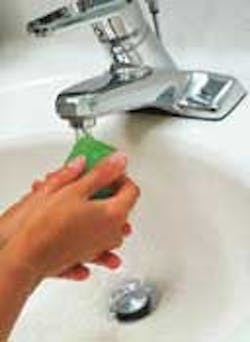Whats Going Down Your Drain?
According to a Johns Hopkins researcher, an anti-bacterial agent commonly found in soaps and detergents has been found in water from streams and wastewater treatment plants in the Baltimore area.
The chemical, triclocarban, was not found in well water or municipal drinking water, but was found in samples from six streams as well as wastewater treatment plants in the Baltimore area.
"We put out almost a million pounds of this every year, and nobody ever bothered to take a look what happens to the stuff once we are done with it," said study author Rolf U. Halden, assistant professor of the School's Department of Environmental Health Sciences and founding member of its Center for Water and Health.
"We pick up a bar of soap, the material gets washed down, goes to the wastewater treatment plant, and a lot of it ends up in our surface water."
Triclocarban is not one of the chemicals whose presence in drinking water is monitored or regulated by the federal Environmental Protection Agency, but the EPA is reviewing it, Halden said.
The chemical was found in surface water at levels up to 20 times higher than those reported to the EPA by the chemical industry, said Halden, who added that his group now plans a wider study of the chemical in surface waters nationwide. Results of the study have been published in the online edition of Environmental Science & Technology.
The group had to develop a new test to detect the chemical because conventional monitoring techniques cannot detect it, said the reseacher.
"Now the big question is what are the ecological and human health consequences of triclocarban in the environment? From the chemical structure, one would expect the compound to concentrate in fish and bio-accumulate in the food chain, but at this point we can only speculate," Halden said.
A website posted by Frederick Senese, an associate professor of chemistry at Frostburg State University, who was not involved in the study, says triclocarban kills bacteria by blocking an enzyme that many bacteria and funguses need for survival.
The highly specific way that triclosan kills also has researchers concerned about its role in fostering antibiotic-resistant strains of bacteria, the website says.
Halden said the researchers tested water entering and leaving the city's three water treatment plants as well as samples from the Jones Falls, Gwynn's Falls, Gwynn's Run, Maiden's Choice Run, Western Run and Stony Run.
Halden said it is "somewhat unsettling that we've been using this persistent disinfectant for almost half a century at rates approaching 1 million pounds per year and still have essentially no idea of what exactly happens to the compound after we flush it down the drain."
Source: U.S. Water News
